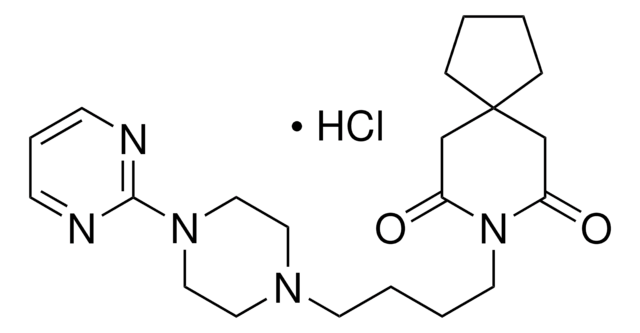SCP0142
ET Antag PD 156252
Anmeldenzur Ansicht organisationsspezifischer und vertraglich vereinbarter Preise
Alle Fotos(1)
About This Item
Empirische Formel (Hill-System):
C53H69N7O10
Molekulargewicht:
964.16
UNSPSC-Code:
12352200
NACRES:
NA.32
Empfohlene Produkte
Assay
≥95% (HPLC)
Form
lyophilized
Zusammensetzung
Peptide Content, ≥85%
Lagerbedingungen
protect from light
Lagertemp.
−20°C
Amino Acid Sequence
Ac-Bhg-Leu-Asp-Ile-NMeIle-Trp
Anwendung
PD-156252 is used as an endothelin-A/endothelin-B (ETA/ETB) receptor antagonist.
Lagerklassenschlüssel
11 - Combustible Solids
WGK
WGK 3
Flammpunkt (°F)
Not applicable
Flammpunkt (°C)
Not applicable
Hier finden Sie alle aktuellen Versionen:
Analysenzertifikate (COA)
Lot/Batch Number
Die passende Version wird nicht angezeigt?
Wenn Sie eine bestimmte Version benötigen, können Sie anhand der Lot- oder Chargennummer nach einem spezifischen Zertifikat suchen.
Besitzen Sie dieses Produkt bereits?
In der Dokumentenbibliothek finden Sie die Dokumentation zu den Produkten, die Sie kürzlich erworben haben.
W L Cody et al.
Journal of medicinal chemistry, 40(14), 2228-2240 (1997-07-04)
The endothelins (ETs) are a family of bicyclic 21-amino acid peptides that are potent and prolonged vasoconstrictors. It has been shown that highly potent combined ETA/ETB receptor antagonists can be developed from the C-terminal hexapeptide of ET (His16-Leu17-Asp18-Ile19-Ile20-Trp21), such as
Endothelin receptor antagonists: an overview of their synthesis and structure-activity relationship.
Javed Iqbal et al.
Mini reviews in medicinal chemistry, 5(4), 381-408 (2005-04-28)
Endothelins (ETs) are potent vasoconstrictor peptides and are associated with several disease states like pulmonary hypertension, systemic hypertension and heart failure. Endothelin-1 (ET-1) is the first member of the family and it has the receptor subtypes known as ETA and
Pierre Shephard et al.
Thrombosis and haemostasis, 92(2), 262-274 (2004-07-23)
Myofibroblasts are specialized fibroblasts that contribute to wound healing by producing extracellular matrix and by contracting the granulation tissue. They appear in a phase of wound healing when the dermis strongly interacts with activated epidermal keratinocytes. Direct co-culture with keratinocytes
Unser Team von Wissenschaftlern verfügt über Erfahrung in allen Forschungsbereichen einschließlich Life Science, Materialwissenschaften, chemischer Synthese, Chromatographie, Analytik und vielen mehr..
Setzen Sie sich mit dem technischen Dienst in Verbindung.







